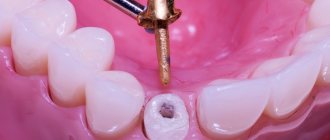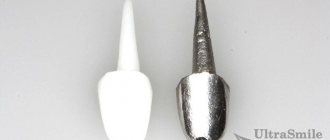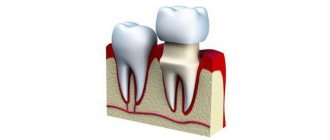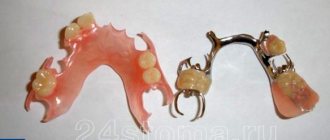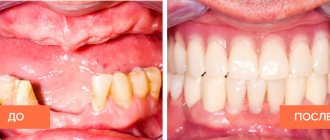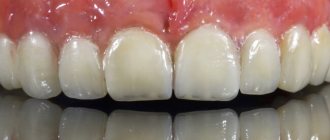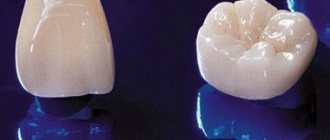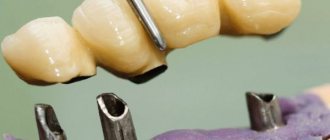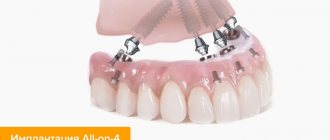KHS, prosthetics
Clasp dentures
We will try to dispel myths and idle speculation regarding the use of titanium in dentistry. The first thing you need to understand is that titanium is not an alloy (often said to be a titanium alloy), it is pure Ti
number 22 on the periodic table. It is pure titanium that has taken a strong place in surgery and dentistry. Many people know how this unique metal is used in reconstructive surgery - plates for the skull, pins for repairing bone fractures, artificial joints - the femoral neck, for example. As you can see, titanium has taken a strong place in the human body and has proven itself to be biocompatible. Titanium has been used in orthopedic dentistry for quite some time. This was due to technical difficulties when working with this metal and therefore less “capricious” materials were used everywhere - stainless steel, alloys of cobalt, chromium, nickel, gold.
Titanium Discovered in 1789 by Klaproth, titanium did not find practical use for a long time due to its fragility. The purest titanium obtained in 1925 by Van Arkel and de Boer using the iodide method turned out to be a ductile and manufacturable metal with many valuable properties that brought it to the attention of a wide range of designers and engineers [2].
For reference. In 1953 A.I. Doinikov et al. A cobalt-chromium alloy (CHS) has been developed and produced. The alloy is based on cobalt, which has high mechanical properties. Chromium is used to give the alloy hardness and anti-corrosion properties. Molybdenum gives the alloy a fine-crystalline structure, which enhances the strength properties of the alloy. Nickel increases the toughness of the alloy. Molybdenum in small quantities improves the quality of casting, improves fluidity, lowers the melting point, and helps remove gases and sulfur compounds. The iron admixture is no more than 0.5%, since it increases shrinkage during casting and worsens the physicochemical properties of the alloy [1].
Traditional alloys An alloy of biologically incompatible metals, and currently the focus is on the issues of biological compatibility and bioadaptation of alloys.
Why, anything else?
The negative impact of metal inclusions in the oral cavity has been studied since the end of the 19th century. All metals used in orthopedic dentistry are destroyed under the influence of mechanical factors and the chemical composition of saliva. The most severe pathological changes were observed in patients with prostheses made of dissimilar metals and it was recommended to especially avoid the gold-stainless steel pair. Metal fillings and crowns change the ionic composition of saliva: a direct relationship has been established between trace elements and microcurrents in the oral cavity. Gallodent, amalgam and stainless steel are especially distinguished in terms of the height of electrical potentials. Electrogalvanic and allergic complications are based on corrosion, and the aggravating factor is the period of use of the prosthesis. As a result of the interaction between the tissues of the oral cavity and saliva, Co, Cr, Ni penetrate through the mucosa and have the ability to accumulate. Metal inclusions, especially in combination, have an adverse effect on the receptor apparatus of the oral cavity and the body as a whole. When using stainless steel prostheses, a large amount of Cr is released, which accumulates in the internal organs. The toxic effect of chromium is manifested by dystrophic changes in the kidneys, the appearance of protein in the urine, dysfunction of the gastrointestinal tract, gastric and duodenal ulcers. KHS is not without its shortcomings. It can also cause pathological changes in the oral cavity. Cobalt and nickel are allergens (haptens) and cause allergic lesions of the oral mucosa in people who have dentures made of stainless steel and chromium-cobalt alloy. The most active allergen in terms of the frequency of reactions caused is nickel. When using these dentures, patients experience a feeling of acidity, burning in the mouth, dryness, and discomfort. Most often this occurs as a consequence of the manifestation of electrochemical corrosion and the occurrence of microelectrogalvanic currents. To eliminate the unfavorable background, all inclusions must be replaced with indifferent ones, rather than avoiding dissimilar metals. The negative impact of CCS on human organs has led to the need to search for new materials with improved characteristics for orthopedic treatment of patients. The use of titanium alloys for otropedic dentistry has recently attracted great interest.
Nickel chrome alloy
Never neglect to ask the dentist if they issue quality certificates for their products, certificates from the manufacturer and a guarantee from the clinic for finished products, only in this case you can be sure of receiving quality services. If you are installing a nickel-chromium metal-ceramic structure, then be sure to check what percentage of chromium content is in the alloy; if they can’t answer you, you should think about it, and whether you should trust your health to this dental clinic at all.
Nickel-chromium metal-ceramic crowns have a great advantage in terms of cost , but if we consider their quality and biocompatible characteristics, they come in last place. The metal frame of such crowns is very soft, compared to other metals and alloys, which will affect the consumption of hard foods; with prolonged use, cracks and chips of the enamel may appear; the manufacturer of such crowns also applies simple and inexpensive ceramics to such a base, and of course However, the warranty period is always much shorter than for products made from other materials.
Nickel-chromium alloy is approved for use in dentistry, it is not dangerous to human health, but nevertheless, the specialists of our dental center strongly recommend that patients pay attention to metal-ceramic crowns made of other materials and alloys, this is due to the durability of the crowns, there is a possibility that a person’s own teeth may not be able to withstand changing crowns every 4-6 years, for which nickel-chrome crowns are designed; in addition, these crowns are the heaviest of all structures, and the “bridge”, which is long and installed on the upper teeth, can lead to your own teeth coming out of their sockets, which will subsequently lead to their loss.
Taking into account all the above facts, the specialists of our clinic concluded that crowns made of nickel-chromium alloy cope perfectly with their function, but only if the prosthesis is small (1-3 teeth), which are located on the lower jaw and are not subject to heavy loads when chewing, and not included in the smile zone, since a blue stripe may appear in the gum area over time, which reveals the crowns and distinguishes them from real teeth, the best place for installation is the lower premolars.
Advantages:
- price
Flaws:
- heavy, not suitable for installation on the upper jaw,
- Nickel in the composition can cause allergies,
- soft frame and covering,
- short warranty period.
In any case, the final decision remains yours; we can only advise and inform you about the quality mechanical characteristics of each type of crown, so that when choosing, you are informed about all the pros and cons of crowns.
Cobalt-chrome alloys grade KHS
⇐ PreviousPage 5 of 5
COMPOUND:
· cobalt
66-67%, giving the alloy hardness, thus improving the mechanical properties of the alloy.
· chromium
26-30%, introduced to impart hardness to the alloy and increase anti-corrosion resistance, forming a passivating film on the surface of the alloy.
· nickel
3-5%, increasing the ductility, toughness, and malleability of the alloy, thereby improving the technological properties of the alloy.
· molybdenum
4-5.5%, which is of great importance for increasing the strength of the alloy by making it fine-grained.
· manganese
0.5%, increasing strength and casting quality, lowering the melting point, helping to remove toxic granular compounds from the alloy.
· carbon
0.2%, which reduces the melting point and improves the fluidity of the alloy.
· silicon
0.5%, improving the quality of castings and increasing the fluidity of the alloy.
· iron
0.5%, increasing fluidity, increasing casting quality.
· nitrogen
0.1%, which reduces the melting point and improves the fluidity of the alloy. At the same time, an increase in nitrogen of more than 1% worsens the ductility of the alloy.
· beryllium
0-1,2%
aluminum 0.2%
PROPERTIES:
KHS has high physical and mechanical properties, relatively low density and excellent fluidity, allowing the casting of openwork dental products of high strength. The melting point is 1458°C, the mechanical viscosity is 2 times higher than that of gold, the minimum tensile strength is 6300 kgf/cm2. The high modulus of elasticity and lower density (8 g/cm3) make it possible to produce lighter and more durable prostheses. They are also more resistant to abrasion and retain the mirror-like shine of the surface given by polishing for a longer time. Due to its good casting and anti-corrosion properties, the alloy is used in orthopedic dentistry for the manufacture of cast crowns, bridges, various designs of solid-cast clasp dentures, frames of metal-ceramic dentures, removable dentures with cast bases, splinting devices, cast clasps.
PRODUCTION FORM: produced in the form of round pieces weighing 10
and 30g, packed in 5 and 15 pcs.
All produced metal alloys for orthopedic dentistry are divided into 4 main groups:
1. Byugodents
— alloys for cast removable dentures.
2. KH-Dents
— alloys for metal-ceramic prostheses.
3. NH-Dents
— nickel-chrome alloys for metal-ceramic prostheses.
4. Dentans
— iron-nickel-chrome alloys for dentures.
1.Byugodents.
They are a multicomponent alloy.
COMPOSITION: cobalt, chromium, molybdenum, nickel, carbon, silicon, manganese.
PROPERTIES: density - 8.35 g/cm3, Brinell hardness - 360-400 HB, melting point of the alloy - 1250-1400°C.
APPLICATION: used for the manufacture of cast clasp dentures, clasps, splinting devices.
· Bygodent CCS vac (soft)
— contains 63% cobalt, 28% chromium, 5% molybdenum.
Byugodent CCN vac (normal
) - contains 65% cobalt, 28% chromium, 5% molybdenum, as well as a high carbon content and does not contain nickel.
Byugodent CCH vac (solid)
- the basis is cobalt - 63%, chromium - 30% and molybdenum - 5%. The alloy has a maximum carbon content of 0.5%, is additionally alloyed with niobium - 2% and does not contain nickel. It has exceptionally high elastic and strength parameters.
·Byugodent SCC vac (copper)
- the base is cobalt - 63%, chromium - 30%, molybdenum - 5%. The chemical composition of the alloys includes copper and a high carbon content - 0.4%. As a result, the alloy has high elastic and strength properties. The presence of shallows in the alloy facilitates polishing, as well as other mechanical processing of prostheses made from it.
Byugodent CCL vac (liquid)
- in addition to cobalt - 65%, chromium - 28% and molybdenum - 5%, the alloy contains boron and silicon. This alloy has excellent fluidity and balanced properties.
2.KH-Dents
APPLICATION:
used to make cast metal frames with porcelain linings. Oxide film formed
on the surface of alloys, allows the application of ceramic or glass-ceramic coatings. There are several types of this alloy: CS, CN, CB, CC, CL, DS, DM.
KH-Dent CN vac (normal
) contains 67% cobalt, 27% chromium and 4.5% molybdenum, but does not contain carbon and nickel. This significantly improves its plastic characteristics and reduces hardness.
KH-Dent CB vac (Bondy)
has the following composition: 66.5% cobalt, 27% chromium, 5% molybdenum. The alloy has a good combination of casting and mechanical properties.
3.NH-Dents
COMPOSITION: nickel - 60-65%; chromium - 23-26%; molybdenum - 6-11%; silicon - 1.5-2%; do not contain carbon.
NH-Dent alloys on a nickel-chrome base
APPLICATION:
for high-quality metal-ceramic crowns and small bridges, they have high hardness and strength. Denture frames can be easily ground and polished.
PROPERTIES:
the alloys have good casting properties and contain refining additives, which allows not only to obtain a high-quality product when casting in high-frequency induction melting machines, but also to reuse up to 30% of the gates in new melts. There are several types of this alloy: NL, NS, NH.
NH-Dent NS vac (soft
) - contains nickel - 62%, chromium - 25% and molybdenum - 10%. It has high dimensional stability and minimal shrinkage, which makes it possible to cast long bridges in one step.
NH-Dent NL vac (liquid
) - contains 61% nickel, 25% chromium and 9.5% molybdenum. This alloy has good casting properties, making it possible to obtain castings with thin, openwork walls.
4.Dentans
PROPERTIES:
Dentan type alloys are developed to replace cast stainless steels. They have significantly higher ductility and corrosion resistance due to the fact that they contain almost 3 times more nickel and 5% more chromium. The alloys have good casting properties - low shrinkage and good fluidity. Very malleable in machining.
APPLICATION: used for the production of cast single crowns, cast crowns with plastic lining. There are several types of this alloy: DL, D, DS, DM.
·Dentan D
contains 52% iron, 21% nickel, 23% chromium. It has high ductility and corrosion resistance, has a small
high shrinkage and good fluidity.
·Dentan DM
contains 44% iron, 27% nickel, 23% chromium and 2% molybdenum. Molybdenum was additionally introduced into the alloy, which increased its strength in comparison with previous alloys, when comparing the same level of workability, fluidity and other technological properties.
For some nickel-chrome alloys, the presence of an oxide film can have a negative effect, since at high firing temperatures, nickel and chromium oxides dissolve in the porcelain, coloring it. An increase in the amount of chromium oxide in porcelain leads to a decrease in its coefficient of thermal expansion, which can cause the ceramic to break off from the metal.
Ticket number 34
Standard artificial porcelain teeth are one of the main elements of complete and partial plate and clasp dentures.
Their main advantage over metal and polymer artificial teeth is their high imitation ability. The reflective qualities of porcelain generally resemble those of natural teeth. The color fastness of porcelain is also unrivaled. In addition, porcelain is very indifferent to the human body and is absolutely indicated for people with hypersensitivity to polymers.
Among the disadvantages of porcelain teeth, one should note their fragility, insufficiently strong connection with the prosthesis base, low abrasion, and technological qualities that are worse than those of polymer teeth. Insufficient strength of the teeth in the area of attachment of the crampons (in crampon teeth) and the hollow part (in diatoric teeth) appears with unfavorable articulatory relationships.
Artificial teeth made from factory-made porcelain are fired according to a special regime. Raw materials made from various components for porcelain masses are called batch. By introducing low-melting additives (fluxes) into the mixture, which include boric acid, lithium carbonate, magnesium oxide and sodium carbonate, the melting temperature is regulated.
The process of burning the charge is called fritting (melting), and the product obtained during sintering is called frit. From the frit, by adding plasticizers (starch paste, dyes, etc.), a molding mass is prepared for the production of artificial teeth from porcelain in a factory. In recent years, vacuum firing of porcelain teeth has been used at the plant.
It should be noted that porcelain teeth are available in various styles and colors:
·the front top and bottom have 8 styles, and the side top and bottom have 4 styles;
·there are 9 color shades that correspond to the color scale of porcelain teeth.
Porcelain front teeth are produced
:
· sets of 12 teeth (6 upper and 6 lower);
· sets of 6 upper teeth or 6 lower teeth separately;
·incomplete set of 4 teeth (2 upper and 2 lower fangs on the right and left sides).
Porcelain lateral teeth are produced:
· sets of 16 teeth (8 upper teeth and 8 lower teeth, consisting of 4 molars and 4 premolars, 2 each on the right and left sides);
·incomplete set of 8 teeth (upper and lower), or 4 upper and 4 lower molars or 4 upper and 4 lower premolars on the right and left sides.
Porcelain teeth can be produced in sets for toothless jaws, 28 teeth each (6 anterior upper, 6 anterior lower and 16 lateral upper and lower).
An album of porcelain teeth is used as a standard when selecting styles and colors of anatomically shaped teeth. In addition, to select the color, a porcelain teeth color scale is used, which is presented in the form of central incisors in 9 color shades (from No. 1 to No. 9).
Abroad, many companies produce artificial porcelain teeth for removable dentures. For example,
(Liechtenstein) produces sets of anterior porcelain teeth Vivoperl-PE and sets of lateral teeth Vivoperl-PE-Orthotype.
Porcelain teeth (Germany) are widely known in Russia. Biodent supplies porcelain teeth in sets of 6 front teeth (USA).
Ticket number 43
CARBODENT
Carbodent is a composite filling material based on acrylic copolymers and the universal binder BIS - GMA, cold-curing powder-liquid type.
PURPOSE: Carbondent is intended for filling anterior, chewing teeth, for the manufacture of temporary structures of fixed dentures (pin teeth, facets, etc.), for restoration of plastic crowns, facets, pin teeth, chewing surfaces of plastic teeth in removable dentures, for fixation of adhesive bridges prostheses.
PROPERTIES: the material contains an active filler – thermochemical
Highly processed fused quartz. The selected optimal amount of filler significantly reduces water absorption, volumetric change and the coefficient of thermal expansion of the material, while at the same time allowing for quick and easy processing and polishing of the filling. Contains an anti-aging agent.
METHOD OF APPLICATION: pour the required amount of powder into a glass cup and add liquid drop by drop until the powder is completely saturated. The powder and liquid are mixed for a few seconds until smooth. The prepared mass is closed and kept for 2 minutes. Excess material is removed 10 - 15 minutes after its application, using spherical burs and abrasive heads.
RELEASE FORM: the Carbondent kit contains a set of powders in 6 colors (0-6-10-12-16-19) 10 g each, liquid – 50 g. A mixing cup, plastic spatulas - 50 pcs., dropper plugs - 2 pcs. Powder numbers 6, 10, 12, 16 and 19 are close in color to the corresponding numbers of the uniform dental color. Powder No. 0 is translucent and can be used either as an addition to the main color in order to give them greater transparency or independently.
MANUFACTURER: Ukraine (Kharkov), “STOMA”.
Ticket No. 38
PROTACRIL – M
Protakryl-M plastic is a fast-hardening powder-liquid type plastic.
PURPOSE: Protacryl-M plastic is used in dental practice for the manufacture of removable dentures, maxillofacial and orthodontic appliances, removable splints - prostheses for periodontitis, repairs and other purposes.
PROPERTIES: powder – fluorine-containing acrylic copolymer, stabilized with an antiaging agent. The liquid is methyl methacrylate containing a cross-linking agent. The introduction of fluorine rubber, a crosslinking agent and an antiaging agent into the plastic composition helps to increase the physical and mechanical properties and durability of products. Protacryl-M plastic is technologically advanced, products made from it are well processed and imitate natural fabrics in color.
RELEASE FORM: Protakryl-M plastic kit contains: Protakril-M powder – 160.0 g, Protakril-M liquid – 100.0 g, Izokol release varnish – 69 – 50.0 g, dichloroethane glue – 40.0 gram.
MANUFACTURER: Ukraine (Kharkov), “STOMA”.
Ticket No. 39, 44
BOXIL
Boxil is an elastic plastic based on filled silicone rubber (hot cure).
PURPOSE: Boxil is intended for the production of individual protective tires for boxing.
COMPOSITION: paste – polymethylsiloxane, aerosil, zinc oxide. The liquid is a catalyst.
RELEASE FORM: Boxil set includes: 120 grams of paste –
3 tubes of 40 gr., 12 gr. liquids – 12 ampoules of 1 g each. or 3 bottles of 4 g.
MANUFACTURER: Ukraine (Kharkov), “STOMA”.
Ticket No. 40
ORTHOCOR
Orthocor is a plastic material based on natural rosin resins, ethylcellulose and fillers.
PURPOSE: Orthocor is used to clarify the boundaries of dentures of the upper and lower edentulous jaws and to obtain functionally suction impressions in case of severe atrophy of the alveolar processes. Orthocor is also used to obtain functionally designed edges of a removable denture and to refine the supporting parts of complex maxillofacial prostheses.
PROPERTIES: Orthocor does not harden in the oral cavity and well reflects the functional characteristics of the mobile and immobile mucosa of the prosthetic bed. The advantage of Orthocor is that it can be left in the patient’s mouth for 15 minutes. up to several hours, during which time the impression receives functionally shaped edges.
METHOD OF APPLICATION: before using Orthocor, it is necessary to sharply tear off the plastic film from both sides of the plate.
To obtain functionally suction impressions, an individual tray is made - a base. The height of the bite in the central occlusion is determined and the Orthocor plate is placed on a hard base, slightly heated over an alcohol lamp or gas burner. In this form, the base spoon with Orthocor is inserted into the oral cavity to obtain an impression under the force of chewing pressure. Functionally designed
edges are obtained with active design. If you receive a print
On finished dentures the patient can chew. The resulting impression is carefully removed from the oral cavity.
To obtain functionally designed edges of a removable denture, Orthocor is applied only to the edges of the denture and is formed using the active method.
RELEASE FORM: the Orthocor set contains five plates of the same configuration with a total weight of 200g.
MANUFACTURER: Ukraine (Kharkov), “STOMA”.
Ticket No. 42
SINMA-74
Sinma-74 is an acrylic fluorine-containing copolymer of hot-curing powder-liquid type.
PURPOSE: Sinma-74 plastic is used in orthopedic dentistry for the manufacture of fixed dentures.
PROPERTIES: Sinma-74 is characterized by increased strength and good elasticity. Dentures made from Sinma-74 plastic have a fluorescent effect inherent in natural teeth.
RELEASE FORM: Sinma-74 plastic is available in ten-color and one-color. The Sinma-74 ten-color set contains: powder of ten colors: No. 4, 6, 8, 10, 12, 14, 16, 19, 20 and 24 – 300 grams; liquid – 150 g., dye concentrates: white (A), yellow (B); brown (B), and gray (D) – 40 gr. Powders of colors 10, 12, 14, 16 and 19 are included in the kit in double quantities. Color concentrates are designed to be added to a base color powder.
The Sinma-74 single-color set contains: 80 grams of powder of one of the colors: No. 10, 16, 19 – 40 gram jars; liquids – 1 bottle.
MANUFACTURER: Ukraine (Kharkov), “STOMA”.
SINMA - M
Sinma-M is a hot-curing acrylic plastic of the powder-liquid type.
PURPOSE: Sinma-M plastic is used in orthopedic dentistry for the manufacture of crowns and lining of fixed dentures (stamped-soldered and solid).
PROPERTIES: powder – suspension grafted fluorine-containing copolymer; liquid is a mixture of acrylic monomers and oligomers. Due to the presence of the oligomer in Sinma-M, the life time of
the consistency of the mass in a plastic state, which makes it possible to model the cladding directly from plastic, apply it evenly and distribute it. Sinma-M plastic provides high aesthetic properties of dentures, thanks to the possibility of layer-by-layer modeling of the prosthesis with masses of different colors.
Plastic can be used for lining dentures using the following methods:
1.Method of modeling veneer directly on the dental frame
prosthesis.
2. Packing plastic into a cuvette.
RELEASE FORM: Sinma-M set contains dentin powder in 8 colors: 6, 10, 12, 14, 16, 19, 20, 24 – 260 g, enamel powder in 2 colors: No. 1 and No. 2 – 40 g ., liquid - 150 g., dye concentrates: white (A), yellow (B), brown (C) and gray (D) - 40 g. Dentin powders in colors 10, 12, 14, 16 and 19 are included in the kit in double quantities. Color concentrates are designed to be added to a base color powder to produce the desired shade.
MANUFACTURER: Ukraine (Kharkov), “STOMA”.
[TM1]
⇐ Previous5
Recommended pages:
Use the site search:
Precious metals
In some cases, metal-ceramic dental crowns are made on a frame made of precious metals: gold, platinum, palladium, and so on. They are expensive, but provide a number of benefits to those who use them. The fact is that such crowns:
- do not cause allergic reactions in people;
- designed for long-term wear, although they are inferior in strength and durability to structures made of cobalt-chromium alloy;
allow you to choose a shade that best matches the natural appearance of your teeth, so they are well suited for prosthetics of front teeth.
